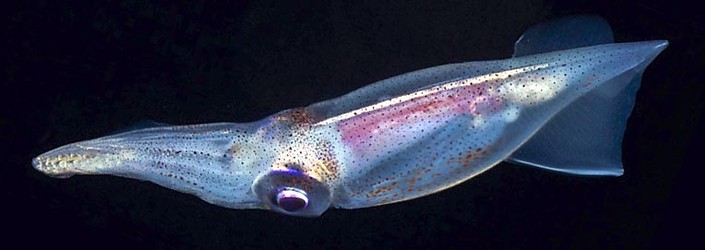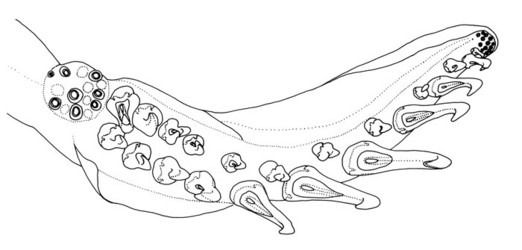Onychoteuthis aequimanus
K.S.R. BolstadIntroduction
Gabb (1868) described Onychoteuthis aequimanus from two specimens collected near the Society Islands. Although it was synonymized with Os. banksii by Adam (1962) and Voss (1962), several subsequent authors have recognized the existence of multiple banksii-affiliated species in the Pacific (Young & Harman 1987, Bolstad 2008). Examination of the syntypes suggests that Os. aequimanus is the correct name for one of these Pacific species.
Characteristics

Figure. O. cf. aequimanus, in dorsal arm-curl posture, side view (in situ photograph, same squid as in title photograph). Top insert: Enlargement showing gladius rostrum (top yellow arrow) and gladius conus (bottom yellow arrow. Bottom insert: Enlargement of club showing terminal pad of right club (yellow arrow) apparently locked to aboral surface of terminal pad of left club. © 2016 Jeffrey Milisen
- Photophores
- Two circular intestinal photophores present. Anterior photophore ~40-60% diameter of posterior photophore.
- Ocular photophore a long whitish patch on ventral surface of each eyeball.
- Measurements of larger syntype
- Mantle length - 93 mm
- Arm lengths - 37-50 mm
- Fin length - 49 mm
- Fin width - 56 mm (damaged)
- Club length - 24 mm (right)
- Club hook numbers - 23
- Largest hooks - Hooks V6 and V7
- Smallest mid-series dorsal hooks - Hooks D4 and D5
- Tentacle club
- Length ~28% ML, with 20–23 hooks.
- Distal-most ventral hook bases not produced into spike below ML ~90 mm; may develop small spike at greater MLs.
Comments
Gabb (1868) remarked that the Os. aequimanus syntypes (two males, ANSP 6444) had been long preserved in alcohol before he received them, and had lost much pigmentation. Their soft tissues have also hardened, the tentacles appear stretched, and the hooks somewhat desiccated. However, most of the important characters (photophores, club morphology overall body proportions, beak and radula) are in reasonable condition.
Distribution
Pacific Ocean, south of 30°N; known from Hawaiian and New Zealand waters, Palmyra Island, and the Society Islands.References
Adam, W. 1962. Céphalopodes de l’Archipel du Cap–Vert, de l’Angola et du Mozambique. Memórias da Junta de Investicacões do Ultramar, second series, 33: 9–64, pl. 1.
Bolstad, K.S. 2008. Two new species and a review of the squid genus Onychoteuthis Lichtenstein, 1818 (Oegopsida: Onychoteuthidae) from the Pacific Ocean. Bulletin of Marine Science, 83: 481–529.
Bolstad, K.S.R. 2010. Systematics of the Onychoteuthidae Gray, 1847 (Cephalopoda: Oegopsida). Zootaxa, 2696: 186 pp.
Gabb, W.M. 1868. Description of a new species of cephalopod from the South Pacific. American Journal of Conchology, 4: 23–24, 1 pl.
Voss, G.L. 1962. List of the types and species of cephalopods in the collections of the Academy of Natural Sciences of Philadelphia. Notulae Naturae, 356: 1–7.
Young, R.E. & Harman, R.F. 1987. Descriptions of the larvae of three species of the Onychoteuthis banksii complex from Hawaiian waters. The Veliger, 29: 313–321.
Title Illustrations

| Location | Off the Kona Coast, Hawaii Island over bottom depths of about 1500 m. |
|---|---|
| Comments | Squid not captured therefore identification uncertain. Tentative identification, from in situ photographs, based on chromatophore pattern of ventral mantle and minimum length of tentacle clubs. |
| Specimen Condition | Live Specimen |
| Identified By | R. E. Young |
| Life Cycle Stage | Young |
| View | Dorsolateral |
| Size | Unknown |
| Copyright | © 2016 Jeffrey Milisen |
About This Page
K.S.R. Bolstad

Auckland University of Technology
Correspondence regarding this page should be directed to K.S.R. Bolstad at
Page copyright © 2019 K.S.R. Bolstad
All Rights Reserved.
- First online 23 December 2010
- Content changed 16 November 2016
Citing this page:
Bolstad, K.S.R. 2016. Onychoteuthis aequimanus . Version 16 November 2016 (under construction). http://tolweb.org/Onychoteuthis_aequimanus/145219/2016.11.16 in The Tree of Life Web Project, http://tolweb.org/










 Go to quick links
Go to quick search
Go to navigation for this section of the ToL site
Go to detailed links for the ToL site
Go to quick links
Go to quick search
Go to navigation for this section of the ToL site
Go to detailed links for the ToL site